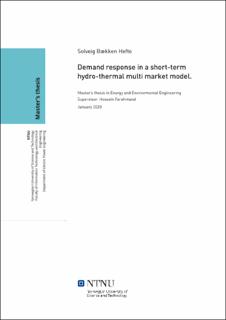| dc.description.abstract | Med den økende andelen av variable fornybare energikilder har behovet for mer balansering i nettet økt. Dette gjennom at disse forårsaker ubalanser i nettet ved at deres potensial for fleksibilitet er lavt og det samme med tregheten.
I fremtiden vil det være et økende behov for fleksibilitet og kontrollerbarhet både på etterspørsel- og produksjonssiden med behov for prisprognoser for alle produkter. SINTEF Energy Research har utviklet en kortsiktig modell for prisprognosering, PriMod. Den optimaliserer kraftplanleggingen med en bedre tilnærming og beregner marginalkostnadene for alle fysiske produkter på en finere tidsskala. Fleksibiliteten på forbrukersiden er ennå ikke formulert her, men er et økende behov siden dette kan redusere prisene i systemet.
Denne masteroppgaven undersøker effekten av prisbasert forbruksrespons gjennom ukentlig planlegging av vannkraftproduksjon i det nordiske systemet. Formålet er å modellere prisbasert forbruksrespons i PriMod med fokus på husholdninger for å fange opp dens påvirkning på systemet. Implementerte metoder er gradvis tilpasning av forbruk og demand side management med fokus på prisbasert forbruksrespons hvor pris justerer forbruk.
De viktigste resultatene viser at prisbasert forbruksrespons vil redusere pris, forbruk i peak hours og forbruk når prisene i systemet og områdene er høyere enn kostnadene for kompensasjon for demand side management. Prisbasert forbruksrespons kan føre til en nedgang i investeringskostnader og lavere strømregninger. Det er sesongvariasjoner, hvor den største prisreduksjon er på vinteren med 1.68%, mens om sommeren og høsten er potensialet lik null på grunn av lave priser. Forskjell i reservoarnivåene har marginal effekt når det gjelder prisbasert forbruksrespons. Det var funnet at vannverdiene var variabelen som påvirket prisen her. Vannverdi ellers påvirkes indirekte av prisbasert forbruksrespons. Den avtar med det økende potensialet for forbruksrespons. Resultatene viser en marginal forskjell for sluttbrukere, men for samfunnet vil dette ha stor påvirkning grunnet reduksjon i nettleie og investeringskostnader. Forbruksrespons kan bidra i balansemarkedet med raskere reserve enn vannkraft. Så lenge forutsetning for forbruksrespons er godt formulert og testet kan det bli brukt i kraftmarkeder og kortsiktige prisprognoser. | |
| dc.description.abstract | With the increasing penetration of variable renewable energy sources, balancing services needed in the grid increases. Intermittent energy causes imbalances in the grid with its lack of flexibility and inertia, affecting the markets of trading power and optimizing the power balance. The importance of flexibility is increasing with the increasing share of power traded closer to the operation time and the fluctuation coming from variable energy resources.
In the future, there will be an increasing need for flexibility and controllability both on the demand and production side with a need for price forecasts for all electricity products. SINTEF Energy Research has developed a short-term multi market model, PriMod. It optimizes the power scheduling in a better approach and calculates the marginal cost for all physical products on a finer time scale. The flexibility on the consumer side has not yet been formulated, and model demand response in a more accurate hydropower scheduling model could decrease the price.
This master thesis investigates the impact of price-based demand response in weekly scheduling of hydropower in the Nordic system. The object is to model demand response into PriMod with the focus on the residential side to capture its impact. Methods implemented are gradual adaption of consumption and demand side management with the focus of price-based demand response where the price adjust the consumption.
The results showed that the impact price-based demand response had on the weekly scheduling model, PriMod, was a decrease in the price, peak-demand, and demand when the prices in the system and area were above the compensation cost of demand side management. Further, price-based demand response led to a decrease in investment costs in the grid and a lower electricity bill. From the seasonal variations, the greatest decrease in price was in the winter which was 1.68% while the summer and fall were 0% due to low prices. Results regarding reservoir level showed a marginal effect as the water values were the main variable that affected the price. The water value is though affected indirectly by price-based demand response as it decreases with the increasing potential of demand response. When flexible loads were increasing it had a good effect with an increasing impact. Altogether this shows a marginal difference for an end-user, but for the social welfare this will have a great impact due to a decrease in the network charges.
Moreover, demand response can contribute to the balancing market under reserve mechanism where they have a great potential to work as a faster frequent reserve in the Nordic balancing market. Demand response has the potential to work closely with all markets as long the assumptions are well formulated and tested as this is one of the greatest barriers towards demand response. The further work of both reserves, how to further implement demand response into balancing services models and motivation for a formulation a new tariff structure is presented. | |
